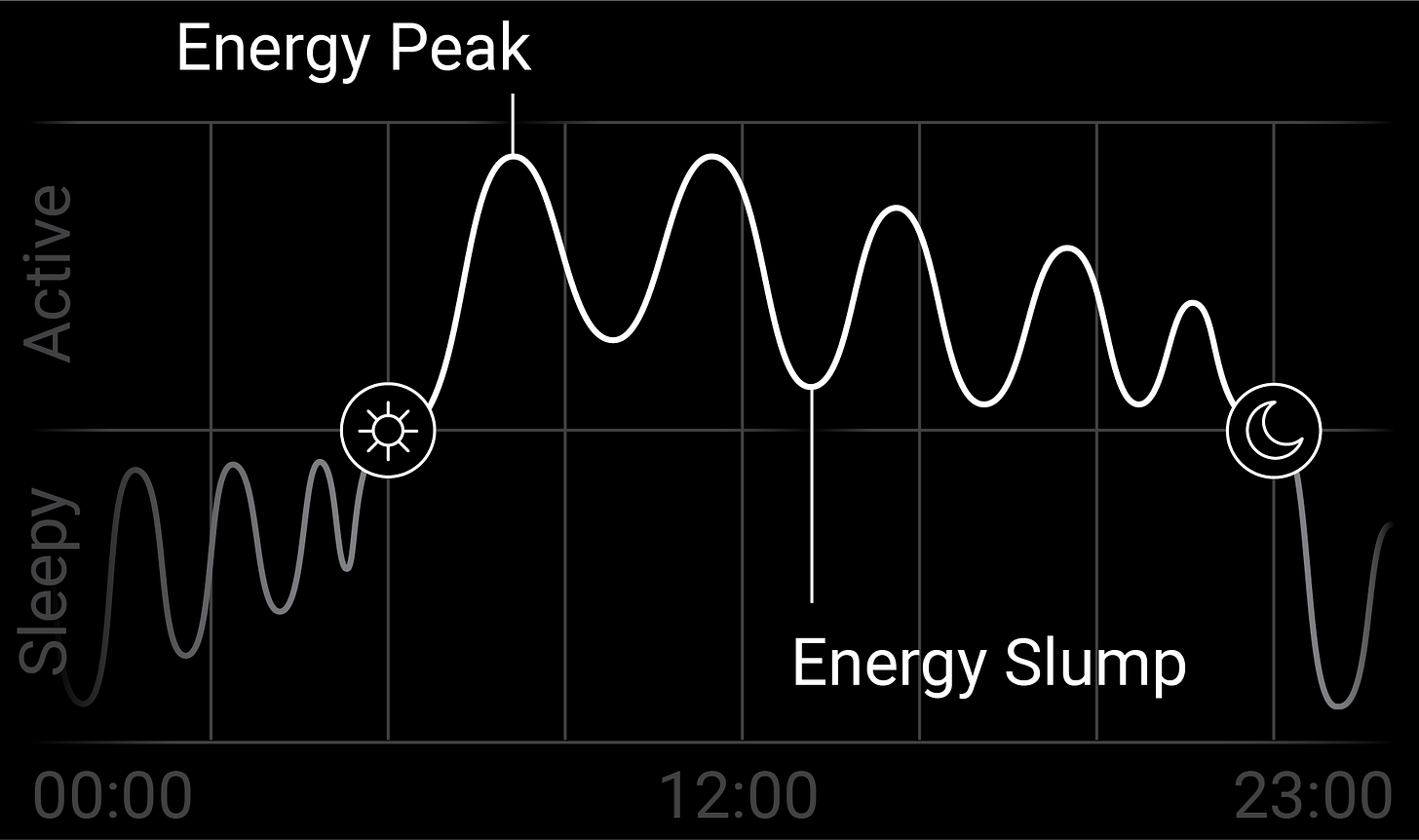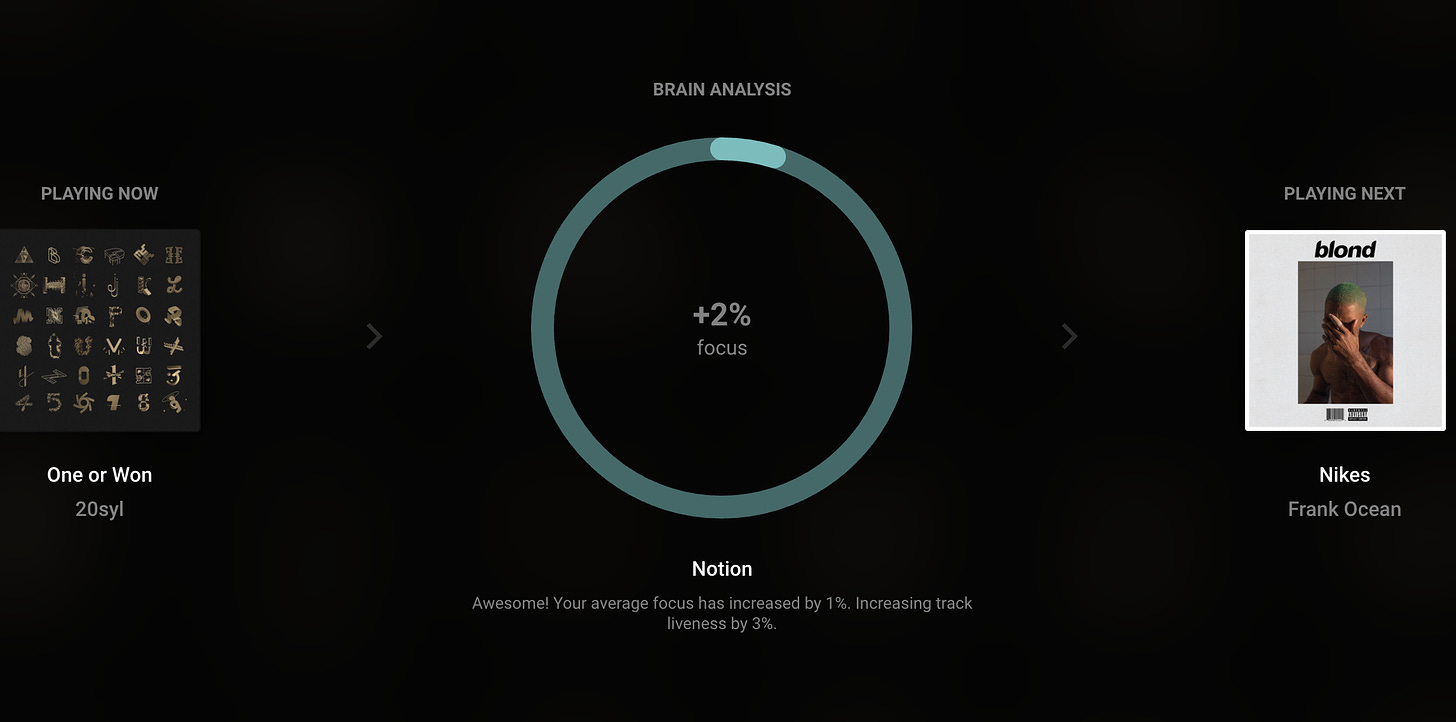On ultradian rhythms and aligning your day to them
What are ultradian rhythms, designing your day around them, and how music can help you align with your biological rhythms

All our bodies are regulated by various biological rhythms, the most well-known of which is the circadian rhythm that governs the 24 hour cycle of sleep and wakefulness aligned with the rotation of the earth.
Public discourse has placed a lot of emphasis on the value and importance of sleep, but far less attention has been paid to the rhythms that occur in our waking states. Most people aren’t attuned to when their brains are optimized for focus and when it’s better suited for a more diffuse flavor of thinking.
What are ultradian rhythms
It turns out that there’s a reasonable amount of scientific data that points to the existence of ultradian rhythms, which oscillate on a shorter time scale than 24 hours. For this discussion, we’re going to focus on a 90-minute rhythm that regulates our ability to focus throughout the day and facilitates memory consolidation at night.
You might already know that throughout the night, we cycle through different stages of sleep at 90-minute intervals. When you wake up in the morning, these ultradian rhythms don’t suddenly just stop — they continue to oscillate throughout the day.

These 90-minute cycles regulate when you are most optimized for focus and learning.
- in the first 5 - 10 minutes, you feel agitation and strain trying to get into focus
- in the middle, it is the optimal time for learning and sustained focus
- in the last 5 - 10 minutes, it becomes hard to maintain focus or learn any more
After 90 minutes of focus, you need to recharge. A study published last year shows that 20 minute naps or light sleep taken shortly after learning has been shown to increase the amount of information learned as well as the retention of that information.
Key takeaway: 90:20 is the ideal ratio of focus to rest.
Now, this ratio doesn’t apply to everyone precisely. More generally, it’s best to focus really hard and then tune out. It’s up to you to experiment with the specifics of your ultradian rhythms and plan your schedule around them. Ask yourself: when are you most and least focused? most lethargic? most anxious? most motivated?
Also, if you’re like me and can’t just nap mid-day, the larger point is that you have to give your brain a rest — whether by taking a walk or making some lunch. There are also a number of scientifically-backed ways to put the brain into states of deep relaxation that we’ll cover in the next section.
Non-sleep deep rest
Another way to think about ultradian rhythms is that they regulate the transitions between alertness and calmness throughout the day, analogously to how circadian rhythms regulate the transition between wakefulness and sleep over 24 hours.
There’s an asymmetry here — most people find it much easier to engage wakefulness and alertness as compared to sleep and relaxation. For example, we can force ourselves to stay up late or pull an all-nighter (some more than others) but we can’t really force ourselves to fall asleep. This might be simply how we’re wired, but it could also stem from societal pressures for productivity at school or work.
Regardless of the cause, a lot of people are not good at falling asleep because they’re not good at calming down. You might have had the experience of trying to sleep after working late or being stressed out, where your mind is stuck in a loop and you can’t disengage from your thoughts.

Key takeaway: it’s very hard to control the mind with the mind.
Andrew Huberman encourages people to look towards the body to control the mind rather than trying to mentally wrestle your mind into a certain pattern of relaxation.
There are 2 non-sleep deep rest (NSDR) protocols that Huberman mentions to access states of deep relaxation, all involving passively listening to 10 to 30 minutes scripts:
- yoga nidra: meditations for relaxation involving breathing & body scans
- digital hypnosis: evidence-backed script to help people fall into deep rest
These protocols are meant to help people learn to relax not just in the moment, but to get better at relaxing and turning off thinking in order to fall asleep when they want to do that at night. They are interventions by which you train your nervous system to go from states of heightened alertness to heightened relaxation.
More generally, for all the time we spend thinking about getting and staying focused, it’s good to also devote time each day to getting better at accessing calm states.
Music as a tool to help you align with your biological rhythms
By expanding your awareness of how your mind usually wants to be engaged or not engaged, you begin to develop an intuition for how to shift into states of deep focus and deep relaxation at different times of day.
That being said, it’s not easy to understand and become attuned to your biological rhythms through self-experimentation — it’s highly subjective and dependent on so many factors. We’re starting to see the emergence of software tools and hardware devices that could help you align with your biological rhythms more robustly.
Music is a particularly fitting medium for this purpose because it’s fairly ubiquitous and it has significant effects on our alertness levels (more on music’s cognitive effects).
Here are a few startups that are leading the charge:
Endel Sound
Endel is an algorithmically-generated, personalized sound environment to help you focus, relax, and sleep. It adapts the sound in real-time based on ultradian rhythms, local weather conditions, time of day, heart rate, and motion. I first covered Endel last year and I’m still using them today — it has definitely lived up to the hype.
Throughout the day, the app helps me better plan out my work by notifying me of when I’m projected to peak and slump in my energy. It also subtly tapers off the intensity of the sound to ease my mind into a relaxed state at the tail end of an 90-minute ultradian cycle.

I’m very excited about how this service continues to evolve, potentially accepting brainwaves as an input in the near future. Speaking of brainwaves…
Neurosity
Neurosity developed one of the first consumer-grade EEG headsets, measuring your levels of focus and calm by interpreting your brainwaves in real-time. The founders want to create a platform for people to start making brain-powered apps, or software that responds to our brainwaves in real-time.
Their first proof-of-concept app is Neurosity Music, which asks you how long you want to focus for and curates music to help you sustain your focus. For example, if your focus begins to slip up, it might cue up a more energetic song to perk you up.

I hope that Neurosity follows Endel’s lead and integrates a model of ultradian rhythms into their recommendation algorithm. Brain-powered apps need to be built with the underlying biological systems in mind to be truly effective.
Looking towards the future, EEG devices will continue to grow smaller and more discrete. We’re already seeing it today with companies like Emotiv releasing a set of EEG earbuds, a perfect form factor to complement the music use case.
Friday Brainstorm Newsletter
For more, join 300+ curious people subscribed to the Friday Brainstorm newsletter. It’s one email a month with the most interesting ideas I've found related to science and health.